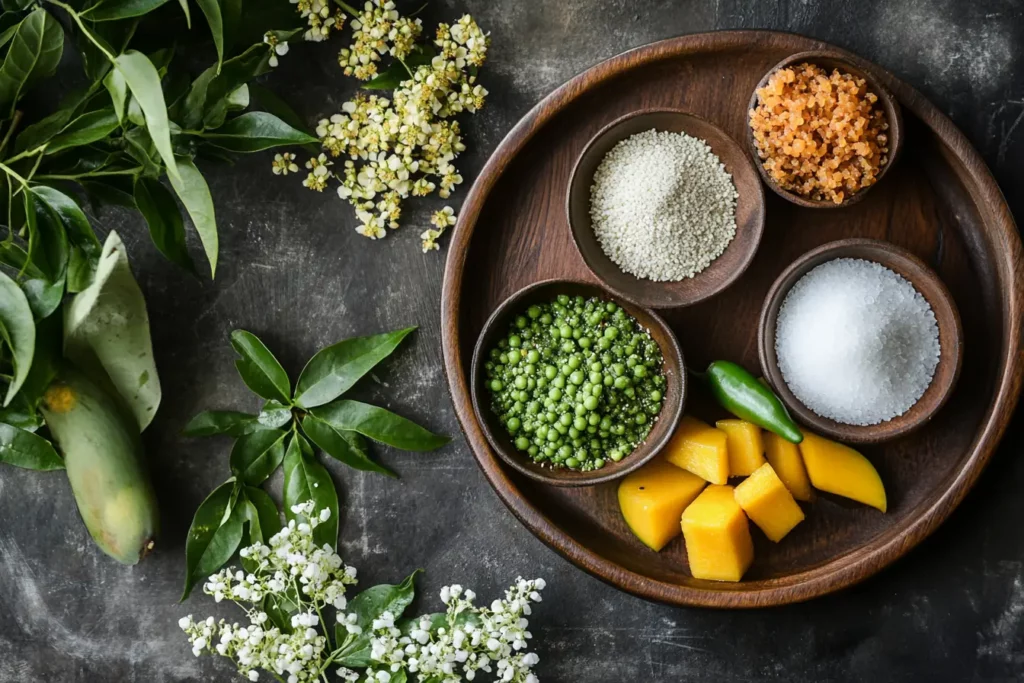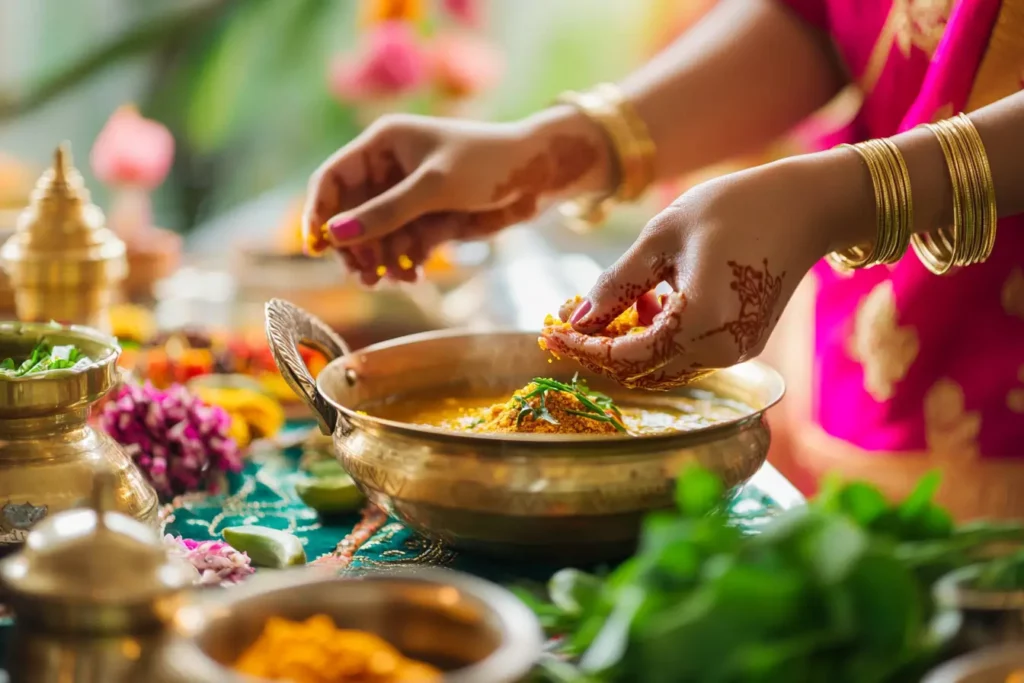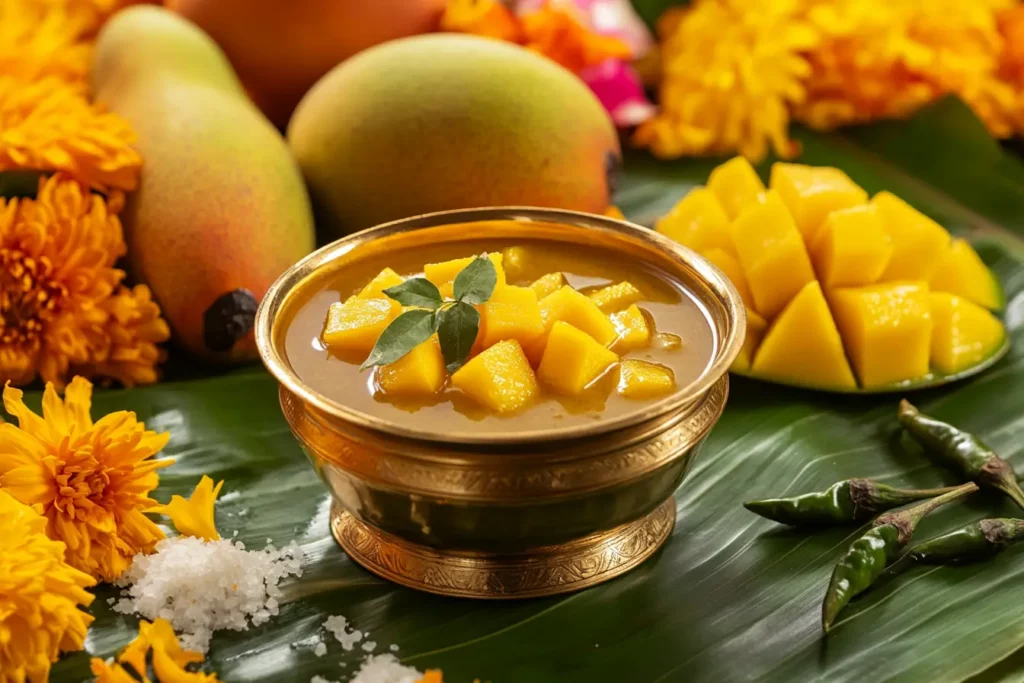Ugadi marks the beginning of a new year for Telugu and Kannada communities. At the heart of this celebration is the traditional Ugadi Pachadi, a unique mixture of six tastes, each representing different experiences of life. This dish isn’t just food—it’s a philosophy on a plate. Combining ingredients like neem, jaggery, tamarind, and raw mango, Ugadi Pachadi mirrors the emotional highs and lows everyone encounters through the year. This article walks you through the origins, ingredients, symbolism, and exact steps to prepare this sacred recipe. Whether you’re new to the festival or honoring family tradition, learning the Ugadi Pachadi Recipe is a flavorful step into cultural wisdom.
Understanding Ugadi Pachadi Recipe and Its Cultural Roots
Ugadi Pachadi Recipe and Its Significance
Ugadi Pachadi is a traditional festive preparation served at the beginning of the Hindu New Year in Andhra Pradesh, Telangana, and Karnataka. The word “Ugadi” stems from Yuga (age) and Adi (beginning), meaning “beginning of a new age.”
The Ugadi Pachadi Recipe is unique because it blends six distinct tastes—each symbolic of life’s different emotions. It reflects a deep-rooted belief that one should embrace life’s happiness, sorrow, anger, fear, surprise, and disgust with equal acceptance. Consumed on Ugadi morning, it sets the emotional and spiritual tone for the year ahead.
According to traditional calendars, Ugadi falls in the Chaitra month, welcoming spring and signaling change. The seasonal ingredients used in the recipe not only suit the local climate but also align with Ayurvedic dietary balance for this period.
Ugadi Pachadi is more than a dish—it’s a message. It teaches balance, patience, and readiness to face all shades of life.
The Role of Ugadi Pachadi Recipe in Telugu and Kannada Traditions
For Telugu and Kannada households, Ugadi is not just a calendar date—it’s the most auspicious beginning. Homes are cleaned, mango leaves decorate entrances, and the Panchanga Sravanam (hearing the yearly astrological forecast) takes place.
The Ugadi Pachadi Recipe is a spiritual centerpiece of the festival. It is typically offered to deities first and then shared with family. Each ingredient used is seasonal, symbolically loaded, and often sourced fresh the same morning.
In Karnataka, the dish may include minor variations, like dry coconut or banana, based on local preferences. However, the core principle remains the same—embracing every aspect of life with a pure and open heart.
In cities like Hyderabad, Vijayawada, and Bengaluru, families gather to prepare Ugadi Pachadi together, passing down the values and tastes across generations. Schools and cultural organizations often host events explaining the dish’s meaning, ensuring its significance is never lost.
Six Tastes of Ugadi Pachadi Recipe Explained
What Are the 6 Flavours of Ugadi Pachadi?
The Ugadi Pachadi Recipe includes six core ingredients, each symbolizing a different taste and a corresponding human emotion. These are not chosen at random—they reflect a centuries-old Ayurvedic philosophy that connects food, emotion, and seasonal balance.
Here are the six primary tastes and their symbolic meanings:
| Taste | Ingredient | Emotion |
|---|---|---|
| Bitter | Neem Flowers | Sadness |
| Sweet | Jaggery | Happiness |
| Sour | Tamarind | Disgust |
| Spicy | Green Chilli | Anger |
| Salty | Salt | Fear |
| Tangy | Raw Mango | Surprise |
These tastes are combined to reflect the human journey. Life doesn’t offer just sweetness or joy. Bitterness and sorrow are part of the same plate. And this dish helps you mentally prepare for a year full of varied emotions and experiences.
Ugadi Pachadi brings a sense of balance. When consumed first thing in the morning, it reminds you that every moment—good or bad—contributes to growth.
How Each Taste Represents Life’s Emotions
Let’s dig deeper into why each taste is linked to an emotion:
- Neem (Bitter): Bitter taste often relates to hardship. Neem represents unpleasant times and sorrow. However, it’s also a purifying agent in Ayurveda, symbolizing spiritual cleansing.
- Jaggery (Sweet): Sweetness signals joy. It’s the flavor of success, love, and kindness. It shows that life offers beautiful moments.
- Tamarind (Sour): The tang of tamarind mimics disappointment. Sour experiences are hard to swallow but necessary to build patience.
- Green Chili (Spicy): Anger is a sharp, instant emotion—like chili heat. This taste represents moments of rage or confrontation.
- Salt (Salty): Salt relates to fear or anxiety. It adds intensity to life’s journey.
- Raw Mango (Tangy): This taste is tied to surprises—both delightful and shocking. It represents unexpected events.
This blend becomes symbolic of emotional awareness and acceptance. Ugadi Pachadi isn’t a dish to be savored only with the tongue, but also with the heart and mind.
Each taste sharpens your awareness of self and surroundings. It grounds your emotions. That’s why this preparation holds such a sacred place in the Ugadi festival.
Ugadi Pachadi Recipe Ingredients List (Traditional)
What Are the Six Ingredients in Ugadi Pachadi?

The classic Ugadi Pachadi Recipe is built using six easily available ingredients that combine to form the six essential tastes. Here’s a breakdown of what you’ll need for the traditional version, usually served during Ugadi in Telugu-speaking households:
- Neem Flowers (Bitter) – Represents sorrow
- Jaggery (Sweet) – Represents joy
- Tamarind Pulp (Sour) – Represents unpleasantness
- Raw Mango (Tangy) – Represents surprise
- Green Chili (Spicy) – Represents anger
- Salt (Salty) – Represents fear
Each of these ingredients is added in a small, balanced quantity. The goal is not to overpower the palate with one flavor but to create a harmonious mix that touches all parts of your tongue—and your soul.
Here’s a basic ratio table many families use:
| Ingredient | Quantity |
|---|---|
| Neem Flowers (fresh or dried) | 1 tbsp |
| Jaggery (grated) | 2 tbsp |
| Tamarind Pulp | 2 tbsp |
| Raw Mango (finely chopped) | 2 tbsp |
| Green Chili (finely chopped) | 1 small chili |
| Salt | to taste |
The ingredients are mixed in a bowl of water and stirred until they blend. It’s served as a shot-sized portion in small cups early on Ugadi morning—always before breakfast and ideally before any other activity.
Many elders insist that children sip it slowly, not gulp it down. Why? Because you’re meant to taste, think, and reflect.
Seasonal Relevance and Ayurvedic Value of Each Ingredient
Every ingredient in Ugadi Pachadi has been selected not just for taste, but also for Ayurvedic balance and seasonal relevance. Ugadi falls during early spring, a time when digestion can be sensitive and body temperature begins to rise.
Let’s break down the Ayurvedic role of each item:
- Neem: A natural detoxifier, purifies blood, helps with skin issues, and cools the body.
- Jaggery: Acts as an energy booster, rich in iron, and helps counterbalance the bitterness of neem.
- Tamarind: Aids digestion and contains antioxidants. It reduces bloating and strengthens gut health.
- Raw Mango: High in vitamin C, supports immunity, and adds a refreshing sharpness.
- Green Chili: Stimulates metabolism and increases appetite during seasonal transitions.
- Salt: Maintains electrolyte balance and enhances taste perception.
Together, these form a balanced seasonal tonic that works with the body’s natural rhythm and digestive fire (Agni). While modern supplements may try to mimic this, Ugadi Pachadi does it in its purest form—straight from nature to your kitchen.
Special Variations: Ugadi Pachadi Recipe for Vagaru
What Are the Ingredients in Ugadi Pachadi Recipe for Vagaru?
While the classic Ugadi Pachadi Recipe remains consistent across many Telugu households, there’s a unique regional variation known as Vagaru Ugadi Pachadi. This version is especially popular in Telangana and certain parts of Andhra Pradesh. It follows the same six-taste philosophy but includes slight changes in preparation and additions for depth in flavor.
Here’s howUgadi Pachadi Recipe for Vagaru is made:
- Toor Dal (Cooked and Smashed): Adds a creamy texture and enhances protein content.
- Coconut (Grated or Thin Slices): Adds mild sweetness and crunch.
- Banana (Chopped): Balances the strong tastes with a mellow finish.
- Black Pepper (Optional): Introduced for mild pungency in place of chili.
- Water or Buttermilk Base: Instead of plain water, this version often uses diluted buttermilk to give the pachadi a slight tang.
Additional ingredients in this variation:
- Tamarind pulp
- Grated jaggery
- Neem flower powder (if fresh is unavailable)
- Salt
- Green chili or pepper
- Raw mango
- Water or buttermilk
The ingredients are still symbolic of the six tastes. However, the Vagaru version includes richness and complexity, making it heartier and more festive. This version is often served in temples or large community gatherings during Ugadi celebrations.
Regional Variations and Why They Matter
Food traditions in India change subtly every few kilometers. With Ugadi Pachadi, these regional touches reflect not only flavor preferences but also climatic and cultural differences.
In Rayalaseema, families might add black sesame seeds to align with local harvests. In Coastal Andhra, dry coconut is favored, and in urban Bengaluru, fresh banana is often used to encourage kids to consume the pachadi more easily.
What stays consistent across regions is the philosophical core of the Ugadi Pachadi Recipe: celebrating the full spectrum of life. Whether made with coconut, pepper, or banana, the intention is clear—balance, reflection, and renewal.
This flexibility also shows how each household adds its own meaning and memory to the dish. Some families associate the smell of neem and tamarind with their grandmother’s kitchen; others remember splitting raw mangoes under the summer sun with cousins.
No matter the region, every Ugadi Pachadi Recipe is a symbol of shared emotion and renewal.It’s savory, satisfying, and makes your kitchen smell incredible—especially if you’re into meals with powerful flavor like Seared Scallops with Spicy Cajun Cream Sauce.
The Six Emotions ofUgadi Pachadi Recipe in Practice
What Are the 6 Emotions of Ugadi?
The heart of the Ugadi Pachadi Recipe lies in how it mirrors the six basic emotions every human experiences. Each ingredient corresponds to a specific emotion, reminding us to accept the full spectrum of life with grace. Here’s how each taste translates into an emotion in the Ugadi tradition:
- Neem (Bitter) → Sadness
Life brings moments of pain, loss, and disappointment. Neem symbolizes the acceptance of these truths. - Jaggery (Sweet) → Happiness
Sweet moments are the joys—celebrations, births, victories. Jaggery reminds us of love and warmth. - Tamarind (Sour) → Disgust
Some experiences leave a bad aftertaste. Tamarind helps process rejection or bitterness in life. - Green Chili (Spicy) → Anger
Anger is quick, intense, and sharp—just like chili. It teaches control and discipline. - Salt (Salty) → Fear
Salt’s sharpness evokes alertness. It symbolizes caution, uncertainty, and survival instinct. - Raw Mango (Tangy) → Surprise
Life’s unpredictability, whether pleasant or jarring, is captured in the tang of mango.
Each emotion is necessary. Ugadi is not about denying grief or clinging to happiness. It’s about seeing all emotions as part of a larger picture—like different colors on a palette.
This concept connects deeply with Ayurvedic teachings, where emotional and physical health are intertwined. In fact, Ugadi Pachadi becomes a symbolic therapy—tasting these ingredients is like meditating on life’s real moments.
We often chase only the sweet and avoid the bitter. But the Ugadi Pachadi Recipe reminds us: bitterness builds strength, sourness sparks wisdom, and anger can lead to clarity.
For those who enjoy bold sweet-savory twists, the flavor profile here is more herbaceous, unlike the glaze-forward style of Pineapple Teriyaki Chicken, but both hit the spot for satisfying baked meals.
Connection Between Taste and Emotion in Daily Life
Modern science now agrees with what ancient practices taught: our emotions and food preferences are deeply connected.
- Bitter foods like neem or karela trigger detox responses, both physical and mental.
- Sweet tastes activate serotonin release and comfort the brain.
- Sour or spicy items can trigger adrenaline, heightening emotional states.
- Salt enhances focus but too much can increase stress.
- Tangy flavors awaken curiosity and elevate alertness.
So, when you consume Ugadi Pachadi, you’re not just eating tradition. You’re actively engaging your emotional awareness. In a fast-paced world, this ritual teaches mindfulness—through something as simple as a spoonful of homemade pachadi.
This is also why elders encourage sharing Ugadi Pachadi with family and neighbors. It builds community, sparks conversations, and reminds everyone of the emotional richness life brings.
PART 6: Symbolism Behind the Ugadi Tastes
What Is the Meaning of Ugadi Pachadi Recipe Tastes?
The six tastes in the Ugadi Pachadi Recipe aren’t just culinary—they’re deeply symbolic. Every ingredient carries a layered meaning rooted in philosophy, culture, and spirituality. In fact, the dish serves as a spiritual reminder that life is a blend of both joy and sorrow, and one must accept all of it with humility and readiness.
Let’s break down the deeper symbolism behind each taste:
- Bitter (Neem): Reflects the harsh realities and struggles in life. It prepares the soul for endurance and teaches detachment from material desires.
- Sweet (Jaggery): Represents prosperity and kindness. It encourages gratitude and reminds us to celebrate small joys.
- Sour (Tamarind): Signifies past experiences—some of which leave lasting impressions. It represents reflection and personal growth.
- Spicy (Chili): Suggests challenges that provoke strong reactions. It symbolizes strength and the will to act with purpose.
- Salty (Salt): Mirrors the flavor of truth. It is essential, like honesty and self-awareness.
- Tangy (Raw Mango): Stands for the unexpected. It encourages openness to life’s surprises.
In totality, Ugadi Pachadi Recipe becomes a metaphor for life’s unpredictable rhythm. On Ugadi morning, tasting it is considered a spiritual act—a moment to ground oneself in reality before entering a new year.
Just like seasons change, so do emotional landscapes. The Ugadi Pachadi Recipe asks us to walk into the new year with a full heart, ready to accept all six emotions—not just chase happiness.
This spiritual depth is why Ugadi Pachadi is first offered to God during the morning puja before anyone consumes it. It acts as a sacred offering—an acknowledgment that life is a divine mix of feelings.
Want to know more about food and its deeper spiritual meanings? Check out this post on why traditional Indian dishes often represent more than taste.
How the Tastes Encourage Reflection and Renewal
The concept of reflection is central to Ugadi. While many cultures party into the new year, Ugadi begins with quiet introspection and renewal. The Ugadi Pachadi Recipe sets the tone for this.
It tells you:
- Accept joy, but don’t cling to it.
- Face bitterness, but don’t fear it.
- Recognize anger and learn to channel it.
- Taste surprise and respond with curiosity.
The dish becomes your first lesson of the year. It shows that emotions are just tastes—they don’t last forever, and they can all be balanced.
Many Indian households sit together after sipping the pachadi and discuss what each flavor meant to them. It’s a time to share thoughts, talk about intentions for the year, and revisit old memories.
This shared ritual builds emotional intelligence—something modern life often overlooks. It also makes children more aware of feelings and prepares them for the complexities of adulthood.
Emotional Mapping and Ayurvedic Link
What Are the 6 Basic Emotions and Their Sensory Connection?
In Ayurveda, food is more than nourishment—it’s medicine, emotion, and even memory. The six tastes in the Ugadi Pachadi Recipe are closely connected to the six foundational emotions that shape our daily life. Here’s how this emotional mapping works:
| Taste | Emotion | Element (Ayurveda) | Effect on Mind |
|---|---|---|---|
| Bitter (Neem) | Sadness | Air + Space | Grounds nervous energy |
| Sweet (Jaggery) | Happiness | Earth + Water | Promotes calm and satisfaction |
| Sour (Tamarind) | Disgust | Earth + Fire | Stimulates digestion and insight |
| Spicy (Chili) | Anger | Fire + Air | Increases alertness and action |
| Salty (Salt) | Fear | Water + Fire | Enhances stability and focus |
| Tangy (Raw Mango) | Surprise | Fire + Air | Encourages curiosity and awareness |
By consuming all six tastes together, the mind reaches an emotional balance. This explains why Ugadi Pachadi Recipe is consumed first thing in the morning—it acts like an emotional primer for the entire day, and ideally, the entire year.
This holistic view of food and feeling makes the Ugadi Pachadi Recipe timeless and universal, even in today’s modern, fast-paced world.
Looking for more examples where food meets emotion? Check out how neem in South Indian cooking supports mood, immunity, and gut health.
Ancient Science Behind Taste and Emotional Well-being
In Ayurveda, the six tastes are called “Shad Rasa.” Each rasa affects the three doshas—Vata, Pitta, and Kapha—which in turn influence physical health and emotional states.
- Bitter and Astringent: Reduce Pitta (anger) and balance Kapha (lethargy)
- Sweet: Calms Vata (anxiety) and balances all three doshas
- Sour and Spicy: Increase Pitta, stimulating metabolism and clarity
- Salt: Stabilizes Vata and supports water retention
The Ugadi Pachadi Recipe is designed with this exact principle. It balances all three doshas and emotional responses in just a few spoonfuls.
This wisdom is why Ayurveda considers Ugadi Pachadi not just festive, but therapeutic. It works as a yearly reset, bringing body, mind, and spirit into harmony with the changing season.
As spring begins, temperatures rise, immunity dips, and the mind gets restless. A bowl of Ugadi Pachadi helps correct this imbalance using natural, seasonal ingredients.
How to Prepare Ugadi Pachadi Recipe (Step-by-Step)

Authentic Ugadi Pachadi Recipe Guide
This version of the Ugadi Pachadi Recipe is traditional, straightforward, and follows the seasonal spirit of the festival. The ingredients are fresh, symbolic, and easy to source if you prepare a day in advance.
Here’s what you’ll need:
Ingredients:
- Fresh neem flowers – 1 tbsp (or 1 tsp dried neem powder)
- Grated jaggery – 2 tbsp
- Tamarind pulp – 2 tbsp
- Finely chopped raw mango – 2 tbsp
- Chopped green chili – 1 small (adjust to taste)
- Salt – ½ tsp (adjust to taste)
- Water – 1 cup
Preparation Method:
- Soak a lemon-sized ball of tamarind in half a cup of warm water for 10 minutes. Squeeze out the pulp and strain.
- In a mixing bowl, add tamarind water and dissolve the grated jaggery completely.
- Add chopped green chili, raw mango, and salt into the mixture. Stir well.
- Finally, add neem flowers and mix gently.
- Add more water to adjust consistency as per your preference.
Tips to Balance All Six Tastes Perfectly
- If neem tastes overpowering, reduce it slightly but never skip it—it’s the core symbol of the dish.
- Adjust jaggery based on the sourness of mango and tamarind to avoid overly tangy results.
- If you’re serving kids, finely chop chili or use black pepper for mild heat.
This pachadi is best served fresh and consumed on an empty stomach after morning prayers on Ugadi. It can be refrigerated for a few hours but is traditionally made and served the same morning.
If you want variety, try serving it alongside other quick recipes like Frozen Salmon in Air Fryer or keep it low-carb with a simple veggie side.

FAQs
1. What are the 6 Flavours of Ugadi Pachadi Recipe?
The six flavors are bitter (neem), sweet (jaggery), sour (tamarind), spicy (green chili), salty (salt), and tangy (raw mango). Each represents a human emotion.
2. What are the six ingredients of Ugadi Pachadi Recipe?
Neem flowers, jaggery, tamarind pulp, raw mango, green chili, and salt—each chosen to symbolize a different life emotion.
3. What are the ingredients in Ugadi Pachadi Recipe for Vagaru?
The Vagaru version includes additions like toor dal, banana, coconut, and sometimes pepper. It maintains the original six tastes while enhancing flavor and texture.
4. What are the 6 emotions of Ugadi Pachadi Recipe?
Sadness, happiness, disgust, anger, fear, and surprise. These are matched with the six tastes in the Ugadi Pachadi Recipe.
5. What is the meaning of Ugadi Pachadi Recipe tastes?
They reflect the complexity of life—sweet moments, bitter truths, and surprising events—all wrapped into one symbolic dish.
6. What are the 6 basic emotions?
Psychologically, the six are joy, sadness, anger, fear, disgust, and surprise—mirrored perfectly in the ingredients of Ugadi Pachadi.
Conclusion
The Ugadi Pachadi Recipe is more than a traditional dish—it’s a reflection of human experience. With just six ingredients, it conveys a complete emotional cycle and prepares you mentally for the new year. Whether you follow the classic version or the regional Vagaru twist, the dish holds one core value: accept life fully.
As spring blooms and Ugadi arrives, gather your family, prepare this symbolic mix, and begin your new year grounded in tradition and emotional wisdom.
Ready to taste life—one spoon at a time?



